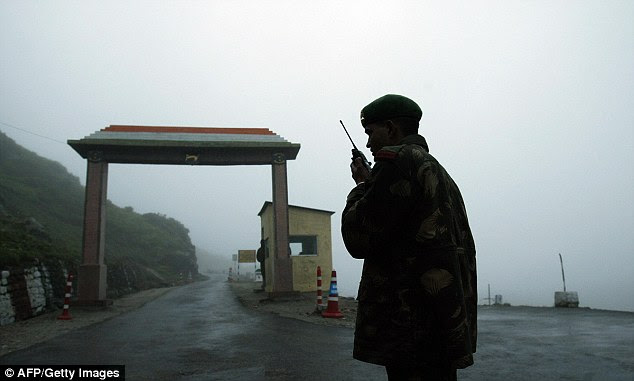China’s refusal to acknowledge Indian national security concerns is now leading to a gradual but significant change in India’s Tibet policy.
The Modi government seems more open than its predecessors in re-evaluating the utility of the Tibet card in managing China.
Shrugging off Beijing’s protests, the Dalai Lama will also be visiting Arunachal Pradesh which China claims as part of its own territory and where Indian government representatives will meet the religious leader.

China’s refusal to acknowledge Indian national security concerns is now leading to a gradual but significant change in India’s Tibet policy (pictured – 1962 Indo-China war)
Damage
The Chinese government has stressed that the Dalai Lama’s visit will cause ‘serious damage’ to China-India ties, as ‘China is strongly opposed to Dalai Lama visiting disputed areas.’
Beijing has suggested that ‘the Dalai Clique has long been engaging in anti-China separatist activities and its record on the border question is not that good.’
Kiren Rijiju, Union minister of state for home affairs, is from Arunachal and is Prime Minister Narendra Modi’s point man on Tibetan issues, will be meeting the Dalai Lama, who is visiting the Buddhist Tawang monastery after an eight-year interval.
In the beginning, the Modi government was willing to cede some ground to Chinese sensitivities on Tibet and hesitated to openly acknowledge official interactions with the Dalai Lama.
But cornered by China’s openly hostile behaviour in recent months, a more public role for the Dalai Lama is being seen as an essential part of Indian response.
President Pranab Mukherjee met the Dalai Lama at the inaugural session of the first ‘Laureates and Leaders for Children’ summit held at the official residence of the President in New Delhi in December.
It was the first meeting in decades between a serving Indian President and the Dalai Lama.
China reacted strongly to this meeting, underlining that New Delhi was disrespecting one of Beijing’s core interests.
New Delhi retorted by arguing that the Dalai Lama was a revered spiritual leader and it was a non-political event.
China has also objected to the planned visit by the Dalai Lama to Arunachal Pradesh this year, saying it would damage bilateral ties with India and amount to New Delhi breaching political commitment on the boundary question.
Just recently, Dai Bingguo, the former Chinese special representative on boundary negotiations with India, has suggested that India holds the key to a final settlement of the border dispute.
If India were to concede Tawang on the eastern front, Dai believes, China will make some concessions in Aksai Chin on the western front.
From New Delhi’s perspective this is a non-starter but it underscores how central the issue of Tibet is in Sino-Indian bilateral matrix.

The Modi government seems more open than its predecessors in re-evaluating the utility of the Tibet card in managing China
Inheritance
Despite being an unsettled inheritance from the British Raj, the Tibet question continues to bedevil Sino-Indian relations to the present day.
The origins of the Sino-Indian war of 1962 in which India was defeated can be traced to the asylum provided to the Dalai Lama after China’s annexation of Tibet.
China’s repressive policies in the Tibet Autonomous Region (TAR) have kept the Tibet question unresolved all these years.
China has called the Dalai Lama a ‘wolf in sheep’s clothing’ and accused him of fomenting separatism in the TAR and by keeping the Dalai Lama an honoured guest, India has continued to earn China’s wrath.
There is growing disenchantment with Chinese behaviour in New Delhi. Appeasing China by sacrificing the interests of the Tibetan people has not yielded any benefits to India and nor has there been tranquility in the Himalayas for the last several decades.
As China’s aggressiveness has grown, Indian policymakers are no longer content to play the rules set by China.
There is more push than ever to support the legitimate rights of the Tibetan people so as to negotiate with China from a position of strength.
Sanctions
Sino-Indian ties are presently passing through a turbulent phase with China extending its ‘technical hold’ on India’s move to get Pakistan-based Jaish-e- Mohammad chief Masood Azhar listed as a terrorist by the United Nations.
Since March 2016, China has been blocking India’s move to put a ban on Azhar, under the sanctions committee of the UN Security Council, despite support from all other members of the 15-nation body.
And in response to India testing its long range ballistic missiles recently, China has indicated that it would be willing to help Pakistan increase the range of its nuclear missiles.

Indian officers occupying one of the forts in the Ladakh region of northern India during border clashes between India and China
The coming to office in Washington of the new Trump Administration with its distinct hard-line approach towards China is adding new pressures on Sino-Indian relations.
The recently concluded China-India Strategic Dialogue has not done much to bridge bilateral differences.
It is at this critical juncture that India wants to reintroduce the Tibet issue in the Sino-Indian strategic calculus.
Given the inherent complexities in pursuing this, it remains to be seen how far the Modi government will go in challenging China on one of its core interests.
But an important change is being ushered in by New Delhi and China will have to take it into account as it continues with its inherently anti-India positions on a range of issues.

